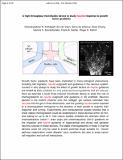A high-throughput microfluidic device to study neurite response to growth factor gradients
Author(s)
Kothapalli, Chandrasekhar R.; de Valence, Sarra; Chung, Seok; Zervantonakis, Ioannis; Gertler, Frank; Kamm, Roger Dale; Van Veen, John; ... Show more Show less
DownloadLabOnAchip_Kothapalli_2011.pdf (1007.Kb)
OPEN_ACCESS_POLICY
Open Access Policy
Creative Commons Attribution-Noncommercial-Share Alike
Alternative title
A high-throughput microfluidic assay to study neurite response to growth factor gradients
Terms of use
Metadata
Show full item recordAbstract
Studying neurite guidance by diffusible or substrate bound gradients is challenging with current techniques. In this study, we present the design, fabrication and utility of a microfluidic device to study neurite guidance under chemogradients. Experimental and computational studies demonstrated the establishment of a steep gradient of guidance cue within 30 min and stable for up to 48 h. The gradient was found to be insensitive to external perturbations such as media change and movement of device. The effects of netrin-1 (0.1–10 µg mL−1) and brain pulp (0.1 µL mL−1) were evaluated for their chemoattractive potential on neurite turning, while slit-2 (62.5 or 250 ng mL−1) was studied for its chemorepellant properties. Hippocampal or dorsal root ganglion (DRG) neurons were seeded into a micro-channel and packed onto the surface of a 3D collagen gel. Neurites grew into the matrix in three dimensions, and a gradient of guidance cue was created orthogonal to the direction of neurite growth to impact guidance. The average turning angle of each neurite was measured and averaged across multiple devices cultured under similar conditions to quantify the effect of guidance cue gradient. Significant positive turning towards gradient was measured in the presence of brain pulp and netrin-1 (1 µg mL−1), relative to control cultures which received no external guidance cue (p < 0.001). Netrin-1 released from transfected fibroblasts had the most positive turning effect of all the chemoattractive cues tested (p < 0.001). Slit-2 exhibited strong chemorepellant characteristics on both hippocampal and DRG neurite guidance at 250 ng mL−1 concentration. Slit-2 also showed similar behavior on DRG neuron invasion into 3D collagen gel (p < 0.01 relative to control cultures). Taken together, the results suggest the utility of this microfluidic device to generate stable chemogradients for studying neurobiology, cell migration and proliferation, matrix remodeling and co-cultures with other cell lines, with potential applications in cancer biology, tissue engineering and regenerative medicine.
Date issued
2010-11Department
Massachusetts Institute of Technology. Department of Biological Engineering; Massachusetts Institute of Technology. Department of Biology; Massachusetts Institute of Technology. Department of Mechanical EngineeringJournal
Lab on a Chip
Publisher
Royal Society of Chemistry
Citation
Kothapalli, Chandrasekhar R. et al. “A High-throughput Microfluidic Assay to Study Neurite Response to Growth Factor Gradients.” Lab on a Chip 11.3 (2011): 497.
Version: Author's final manuscript
ISSN
1473-0197
1473-0189